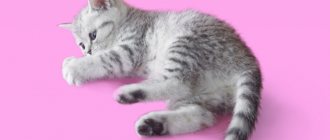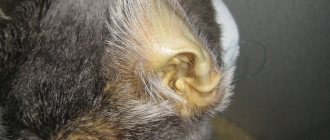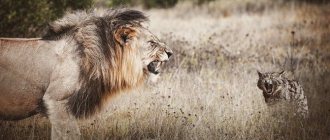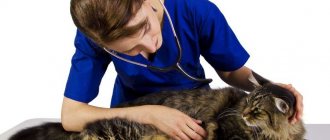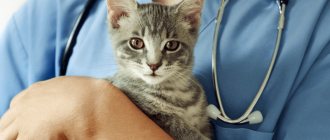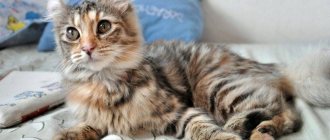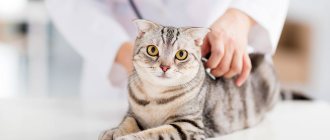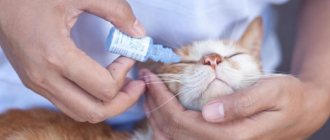9303Pavel
When a cat has a hard stomach, it is necessary to urgently take the animal to a veterinarian. Delay in treatment can lead to the death of your pet. If there is a hard lump in the stomach, then this is also a reason to visit a specialist. The phenomenon may indicate the presence of a tumor or intestinal blockage. Both are extremely dangerous.
Hardness causes tension in the abdominal muscles, which is unnatural. Very often, in addition to this, the cat experiences bloating and other gastrointestinal disorders.
© shutterstock
How can I help my cat at home if she has a stomach ache?
Veterinarians strictly prohibit treating animals with abdominal pain at home. Cats are prescribed intravenous drips containing glucose and saline. To relieve pain, antispasmodics are used - No-Shpa, Papaverine, etc. Inflammatory diseases of bacterial etiology are treated with antibiotics.
However, if an animal needs help and it is not possible to take it to a doctor, you have to make do with home remedies. We can help:
- Enterosorbents. In case of poisoning at home, the cat can be given Enterosgel or activated carbon. The product is dissolved in water and drawn into a syringe from which the patient is given water.
- Diet. Regardless of why the animal has pain, it must comply with food restrictions. Veterinarians recommend feeding sick pets porridge and chicken broth.
Antihelminthic drugs. Because gastrointestinal problems are often caused by parasites, it is recommended that your cat be given a dewormer for abdominal pain. Veterinarians recommend deworming kittens and adult animals every 3 months.
How to recognize the disease?
If the abdomen becomes hard for a short time, this may mean that the cat was frightened and instinctively tensed the abdominal muscles. This condition will pass as soon as the animal calms down. Constipation causes the accumulation of food in the intestines and overstretching of its loops. It is often accompanied by painful spasms, which causes the abdominal wall to involuntarily contract.
If a pregnant cat's abdominal wall is unusually tense, the pet avoids touching, cannot eat and often vocalizes, she may have a pregnancy pathology, for example, spontaneous abortion. If within 36 hours after delivery the cat's belly has not become soft, she has repeated attempts and she does not show attention to the offspring, there is a high probability of unfinished labor. In this situation, emergency assistance from a specialist is required.
A hard belly in a cat after giving birth is often a symptom of pyometra, a purulent-inflammatory disease of the uterus. It occurs with high fever, difficulty breathing, and frequent urination. The pet loses its appetite, its thirst increases, and it lies without moving.
If a cat refuses to eat, loses weight, his fur becomes dull, becomes matted and falls out, and hypertonicity of the peritoneum is caused by constipation, he may be a carrier of worms. Blockage of the intestinal lumen by a lump of parasites causes a life-threatening condition - intestinal obstruction. The pathology is indicated by the absence of bowel movements, frequent vomiting and tense abdominal muscles.
Peritonitis occurs when blood, pus, or other fluids enter the abdominal cavity. Its wall reflexively contracts, the temperature rises, constant vomiting, convulsions, and depression occur. An abdominal abscess is manifested by enlargement and tenderness of the abdomen, hardening of the muscles and can lead to perforation of the organ. With ascites, the abdomen becomes swollen, appetite is suppressed, and persistent pain worries.
Trauma often leads to internal bleeding, which can be suspected by the presence of blood in the stool and urine, and the bluish color of the mucous membranes.
If the internal organs have not been damaged, there will be no symptoms other than the hard peritoneum. If a certain area of the abdomen hardens, resembling a lump, a tumor is likely to form.
A hard belly in a cat after sterilization may indicate post-operative swelling, exacerbation of internal diseases, or infection of the suture. If the wound gets infected, phlegmons, abscesses form in this area, and the temperature rises. If granulosa tissue has grown at the suture site, dense localized lumps appear. They do not cause pain to the cat and dissolve on their own over time.
If the abdomen hardens 3-4 weeks after surgery, ligature fistulas are likely to open. In this case, the peritoneum is heterogeneous to the touch, covered with pustules, and skin hyperemia is observed. This condition occurs due to improper postoperative care or injury to the sutures by the cat itself. Gallstones can cause a hard belly in a cat. The skin and mucous membranes become jaundiced, and an attack of colic causes aggression and anxiety.
What is ascites in cats?
Ascites (edema of the abdomen or peritoneum) is the accumulation of a large amount of exudate in the abdominal cavity of an animal. Under normal conditions, intra-abdominal fluid is present in a much smaller volume: it ensures the normal functioning of organs and the free movement of intestinal loops, removes pathogens and removes toxins. Absorption of this exudate is carried out by the peritoneum itself. With the development of acute or chronic pathologies and under the influence of certain harmful factors, the secretory and barrier function of the peritoneum is disrupted, which leads to the formation of dropsy.
Excess free fluid in the abdominal cavity causes compression of the internal organs. This may contribute to the development of secondary complications.
The cat's abdomen contains many organs: the stomach, intestines, liver, spleen and kidneys.
Causes and conditions for the development of ascites:
- improperly organized nutrition of the animal (with a deficiency of proteins and beneficial microelements);
- prolonged fasting;
- the presence of diseases or injuries of internal organs;
- bacterial or parasitic infectious pathologies.
Video: Veterinarian talks about abdominal hydrops
Table: diseases that cause ascites in cats
| Name of disease group | Pathogenetic mechanism | What pathologies are included? | Other symptomatic manifestations | Time of appearance of abdominal hydrops |
| Abdominal injuries | Damage to internal organs, peritoneum and blood vessels, accompanied by a violation of their integrity |
|
| Within a few hours after injury |
| Malignant and benign neoplasms | Tumor cells affect the peritoneum, which is accompanied by an increase in fluid volume and the development of ascites |
|
| For several weeks |
| Damage to the cardiovascular system | The heart does not have enough strength to move blood through the vessels, as a result of which pressure increases in the arteries and veins of the abdominal cavity: their walls begin to leak fluid |
|
| Within a month |
| Peritonitis | Inflammation of the peritoneal layers, accompanied by the formation of excess fluid |
|
| About 2 hours from the onset of the inflammatory process |
| Liver and kidney diseases | Impaired ability of the liver and kidneys to remove water and toxins, as well as compression of the venous vessels, causes the development of ascites |
|
| For several weeks |
| Infections | Toxins from bacteria, viruses and helminths cause irritation of abdominal receptors, which is accompanied by the production of exudate |
|
|
What do you need to know about this phenomenon?
If a cat has loose skin on its belly, there is no reason to panic or worry. Pets, just like people, have different constitutions. Often cats, even at a young age, recover quickly. Under the influence of stress, changes in weather or other factors, the family pet may lose appetite and lose some excess weight, which will lead to stretching of the skin. This is how a saggy belly appears, also called a fat tail.
Some breeds have loose skin as a characteristic feature. This applies, first of all, to the British, however, ordinary cats taken from the street may differ in the same constitution.
In this case, nothing needs to be done, but veterinarians advise reviewing your pet’s diet, because sagging skin indicates that the cat is overeating.
What is fat tail
A cat has a fat tail - a medium-sized pouch of skin and fat on the abdomen. It happens in dogs too. Scientifically called the primordial or rudimentary sac.
In long-haired individuals, the fur hides the belly, so the tail is inconspicuous. The short-haired cat and the Sphynx have a pronounced skin formation.
The cat's belly hangs from behind, in the area of its hind legs. The thickness of the fat tail is determined by the fat layer and varies.
Domestic cats inherited their fat tails from their wild relatives. In the latter, the sagging of the abdomen is pronounced; the bag sways noticeably when walking and jumping. And in domestic cats, a hanging tummy can be almost invisible. The volume of the fat tail varies by season: in spring and summer the fat layer decreases, in the cold period fat increases.
Reasons for appearance
The exact causes of the appearance of a skin-fat pouch in cats have not been established.
Scientific research confirms that functionally the fat tail is an important formation provided for by evolution:
- The stomach of cats is a vulnerable part of the body that is not protected by the skeleton, and abdominal injuries and pathologies are deadly. Scientists believe that the skin bag with a fat layer is a protective formation. Thanks to the fat tail, a cat sneaking during the hunt does not risk scratching or piercing its belly with a sharp branch or stone.
- There is another idea why cats need a primordial sac: it is a storehouse of nutrients. The theory is confirmed by the fact that the fat tail is most noticeable in obese cats, decreases in the summer heat, and increases in the cold season, when the body accumulates fats to prevent winter hunger. In nature, with a prolonged absence of prey, the body begins to consume nutrients from the abdominal pouch.
- The third probable cause of sagging belly is the way cats move. The skeleton of predators is flexible and mobile. During the hunt, the joints of the limbs are stretched, the spinal column bends vertically and horizontally at a significant angle. For freedom of body movements, elasticity and folding of the skin is necessary. The fat tail allows you to bend your spine as much as possible.
- The protective function of the fat tail may be to prevent injury to the abdominal organs during territorial fights with relatives. Cats that are grappling tend to strike hard with their hind paws in the area of the opponent's stomach, tearing the skin with their claws. The fat tail protects the abdominal organs from serious injury.
A cat's bloated belly: causes and what to do
In a cat, bloating can be a consequence of poor nutrition or a symptom of a large number of diseases, including fatal ones. The most common causes of this phenomenon are discussed below.
Constipation, or coprostasis, is a blockage of the large intestine with feces. The causes of coprostasis may be the following:
- A sharp transition from mother's milk to other foods.
- Binge eating.
- Eating bones, especially heat-treated ones.
- Low protein content in the diet.
- Accumulation of hair in the gastrointestinal tract (when licking itself, the cat swallows some hair).
- Dehydration from not drinking enough.
- A large number of worms.
- Prostate enlargement (in males).
- Abscess or cyst in the intestinal tract.
- Obesity.
- Problems with intestinal motility.
The norm is considered to be stool once a day. When feeding natural food, periodic absence of stool for 3 days is acceptable.
- Oblong lumps can be felt in the abdomen.
- Vomiting (often with constipation from wool).
Warm water enema. Vaseline oil - 1 ml per kg of body weight at intervals of 8-10 hours orally (it is important to avoid getting into the lungs). Magnesium sulfate – 20 ml of concentrated water solution, orally.
Hard belly and constipation
Quite often, changes in the tone of the abdominal muscles are associated with constipation. If a cat has a swollen, hard belly and has not had a bowel movement for a long time, the cause of this phenomenon should be sought in the pet’s diet.
Constipation may be associated with helminthic infestation or intestinal obstruction. In the first case, additional symptoms are present:
- frequent vomiting;
- deterioration in wool quality;
- prostration;
- refusal of food.
Constipation is associated with a large number of parasites in the digestive tract and intestines. Constipation causes severe distension of the intestines, which provokes a reflex contraction of the abdominal muscles.
Intestinal obstruction is a dangerous condition that can lead to intoxication of the animal’s body. Pathology develops due to poor nutrition or consumption of inedible items. Characteristic symptoms of intestinal obstruction are a long absence of bowel movements, refusal to eat and constant vomiting. This condition requires hospitalization.
Causes of bloating in adult cats
If your cat has a swollen belly and sides, possible causes may include:
- disturbances of intestinal microflora;
- inflammation;
- swelling;
- internal bleeding;
- tumors;
- parasites.
Bloating in a cat does not bode well.
Important! Only a doctor can make an accurate diagnosis after taking blood, urine and stool tests. If necessary, ultrasound is performed
Accumulations of air and gas
Aerophagy is the swallowing of air during food consumption. If your pet eats food particularly greedily, air gets in, forming bubbles inside.
Another common cause is excess gas production in the intestines. Most often it is associated with an incorrect or unbalanced diet. Foods that can cause bloating:
- fat and other meat waste;
- bread;
- milk;
- dairy products;
- feed with high soy content;
- wheat;
- corn.
The first three products are prohibited from being given to kittens and adult cats. Most dairy products cause flatulence in a kitten. The consumption of the rest should be halved. The accumulation of gases is caused by any spoiled food. Within the normal range, increased gas formation continues for 1-2 hours after eating, and then goes away.
Note! Bloating can be a sign of inflammatory diseases of the gastrointestinal tract, in particular intestinal diseases. If an enlarged tummy is accompanied by symptoms such as vomiting, diarrhea, refusal to eat, apathy and weakness, you should immediately take the animal to a veterinarian
Fluid in the abdominal cavity
If your cat's stomach is bloated and his health is rapidly deteriorating, the problem may be fluid accumulation:
- urine;
- blood (internal bleeding);
- pus and exudate.
Stagnation can be triggered by injury, severe infection, or organ disease in the acute stage.
Overweight
Excess weight alone cannot cause bloating in a cat. The reason is a disruption in the functioning of the gastrointestinal tract. Often, abundant or unhealthy nutrition causes an imbalance of microflora.
As in people, it manifests itself as heaviness in the stomach, flatulence, and the intestines begin to growl. The number of good bacteria responsible for fermentation and digestion of food is reduced, and the bad bacteria that provoke putrefactive processes in the intestines increases.
Obesity itself is not the cause of a bloated belly.
Enlargement of any abdominal organ
In the presence of an inflammatory process, organ tissues can swell 2-3 times. Your pet's belly may swell due to inflammation or swelling of the liver, spleen, or kidneys.
Helminthiasis
A hard, distended belly is one of the signs of helminthiasis (infection with worms). In especially advanced cases, the number of parasites can be in the hundreds, which means additional weight and volume in the abdominal area. Prevention of infestation with medications should be carried out once a season, especially if the cat is often outdoors and in contact with other animals.
Important! Kittens born on the street become infected with helminths from the first days of life. Due to a ball of parasites, the animal's stomach is swollen
Enlargement of the uterus during pregnancy
Bloating in a pregnant cat causes the uterus to become enlarged. In most cases, changes in organ size occur within the normal range. A veterinarian can determine whether the size of the uterus corresponds to the animal’s gestational age.
Tumor
Malignant and benign tumors partially displace organs. In addition, tumors reduce the overall immunity of the body. Only a specialist can diagnose them using ultrasound and other techniques.
For your information! A condition when an animal can only lie down and sleep indicates the last stages of oncology.
Peritonitis
Another reason why a cat's stomach is swollen is peritonitis. This is a dangerous inflammation in the abdominal cavity. It is characterized by purulent and bloody discharge, as well as the outflow of fluid into the abdomen. The area becomes swollen and inflamed. Most often, the cat cannot even walk, eat or drink.
Peritonitis is common among older and recently born cats. In the second case, sterilization is recommended to prevent recurrent peritonitis. An advanced disease leads to irreversible inflammatory processes, internal bleeding, severe swelling, and organ ruptures.
Ascites
If a sick cat has a distended belly, ascites may be the cause. This is the release and accumulation of fluids in the abdominal cavity. Ascites occurs when any disease reaches an incurable stage. Most often, fluid accumulation occurs due to diseases of the gastrointestinal tract and genitourinary system. Modern medicine is not yet able to treat ascites. To alleviate the animal’s condition, the organ that caused the ascites is removed.
Why do kittens have big bellies?
Normally, the belly of a small purr should be soft and of moderate size: a little more after eating, a little less after visiting the tray and on an empty stomach. A very large belly, swollen like a balloon, should alert the owner. This problem occurs in the following situations:
- The presence of worms in the digestive organs - parasitic worms can even settle in the body of domestic cats of any age that do not leave the apartment. What can we say about homeless kittens? Signs of worms in kittens are a hard, large belly and sides against a skinny body, vomiting, diarrhea alternating with constipation, itching in the anus, painful appearance (dull fur, sour eyes), increased or decreased appetite. If there are too many parasites, you can even notice their movement if you observe the baby’s stomach;
- Constipation is the most important reason why a small kitten may have a large belly. Many problems lead to rare and painful bowel movements, such as stress, dysbiosis, and worms. If the kitten does not visit the litter box for 2-3 days, and its belly is swollen and hard, if the baby meows pitifully when trying to relieve itself, you can suspect that constipation is to blame;
- Inappropriate diet and overeating - kittens should eat special food, and not sausages or bread. Eating food that is indigestible by a small body leads to bloating and rumbling stomach, especially if a very small animal is not fed correctly. In addition, the size of the abdomen is also affected by the amount of fluid consumed: the less the kitten drinks, the higher the risk of developing constipation. Also, many babies have an insatiable appetite, which leads not only to problems with bowel movements, but also to obesity and increased gas formation, which also leads to an enlarged abdomen;
- Ascites or abdominal dropsy is a symptom of various ailments: diabetes, kidney failure, liver failure, obesity, heart problems. With ascites, as a rule, rumbling in the abdomen, heavy breathing, stomach and intestinal upsets, and anxiety when touching the abdomen are observed. The kitten needs to be lifted up and the condition of the tummy monitored to recognize ascites. If the belly “falls” down, making the animal’s figure look like a pear, it means that you need to urgently go to the veterinary clinic, as this indicates abdominal dropsy. This problem cannot be eliminated at home;
- A kitten may have a large belly due to liver problems. With hepatitis, symptoms in addition to a bloated tummy against a background of general exhaustion are yellowing of the mucous membranes, fever, diarrhea (light-colored feces), vomiting, dark-colored urine. And cirrhosis is characterized by abdominal dropsy, severe thirst, loss of appetite and weight, convulsions, blurred vision, apathy;
- Malignant tumors of the gastrointestinal tract system - cancer is more often diagnosed in older cats, however, oncological tumors can also occur in babies. With stomach cancer, for example, in addition to bloating, there will also be the following symptoms: pain in the peritoneum, fever, weight loss, weakness, blood in the stool, hair loss. With intestinal oncology, the symptoms are almost the same as with stomach cancer, but they also add flatulence, the smell of rotting breath, diarrhea, which alternates with constipation;
- Infectious peritonitis is another serious reason when, due to liver enlargement and the development of ascites, the kitten has a large belly and diarrhea, vomiting, enlarged lymph nodes, urinary incontinence, convulsions, and fever. Kittens with inflammation of the peritoneum do not grow well, are thin, but their belly looks like a ball;
- Pancreatitis - inflammation of the pancreas often provokes pain and bloating, nausea, diarrhea, refusal to eat, and tachycardia. More often, pancreatitis affects old pets, although this disease also occurs in homeless cats;
- Cushing's syndrome is not a typical disease for young animals, but no kitten is immune from a hormonal disorder. Symptoms of this pathology are weakness, strong thirst and increased appetite, frequent urination, an enlarged abdomen against the background of general dystrophy, a change in behavior for the worse (the animal becomes aggressive), symmetrical patches of baldness, sagging and thin skin.
Flatulence, which is translated as bloating, is an excessive accumulation of digestive gases in the intestines. It may be accompanied by rumbling in the abdomen, hiccups, the passage of gases through the anus, or there may be profuse or explosive discharge of gases (flatulence). Gas formation may be normal, but increased flatulence indicates a disruption in the animal’s digestive system.
Bloat can happen for many reasons, and some of them can be life-threatening for your pet.
Poor nutrition and gases
A kitten's belly may become bloated due to certain foods. Often, flatulence (accumulation of gases in the intestines) results from feeding your pet milk and dairy products (especially for adult animals).
The cause of bloating may be the high content of carbohydrates in the menu: wheat, corn, etc.
Constipation is an accumulation of stool that becomes dry and hard and cannot be passed out on its own. This leads to intoxication of the body, and gases begin to accumulate in the intestines, which cause bloating.
Constipation occurs for many reasons:
- incorrectly composed diet;
- intestinal obstruction;
- accumulation of wool in the stomach;
- congenital anomalies;
- obesity and inactivity.
Swollen intestines from worms
Parasites actively multiply in the pet’s intestines and cause intoxication. Along with bloating, the cat also experiences other symptoms: vomiting, bowel irregularities, and the presence of worms in the feces. Moreover, the cat may be thin, but with a bloated intestine.
The animal eats a lot
Cats that eat very greedily and eat a lot often suffer from flatulence. At the same time, they swallow food without chewing it, which leads to large amounts of air entering the intestines and stomach. As a result, the intestines can swell to incredible sizes. Usually the animals themselves who live in shelters or nurseries eat so greedily.
Diseases of internal organs
Enlarged intestines can be a symptom of serious diseases of the internal organs:
- Pyometra. With this disease, pus accumulates in the cat's uterus, which is accompanied by an enlargement of the abdominal cavity. Associated symptoms: depression, fever (not always present), discharge from the loop.
- Peritonitis. An enlarged abdomen or ascites (accumulation of fluid in the abdominal cavity) accompanies the wet form of coronavirus infection (FIP).
- Tumors. The volume of the abdomen may increase significantly due to a malignant tumor in the abdominal cavity.
Bloating can occur with intestinal obstruction. This condition is life-threatening and requires immediate surgical intervention.
Other factors
It has also been noticed that in older cats (over 10 years old), the collagen fibers in the subcutaneous layer become thinner, the elasticity and turgor of the skin decrease, which is why fat tail appears very often.
Veterinary nutritionists, when prescribing a cat to “lose excess weight,” also often note an increase in the inguinal fold in patients who have lost weight. Especially if the process was intense and was accompanied not only by a transition to dietary nutrition, but also by an increase in exercise.
If the cat has lost a lot of weight and a bag of skin appears in the lower abdomen (while the diet has not changed), then a possible cause may be the progression of chronic diseases (pancreatitis, hepatitis, malignant neoplasms).
Diagnosis of the disease
Making a diagnosis based only on external signs is wrong. This is why a sick cat needs to be taken to the vet. The specialist will make his verdict only after the animal has been examined and taking into account the test results. This may require:
palpation and tapping; medical history (it is important that the cat owner can provide the doctor with as much information as possible about the diseases the pet has suffered); biological blood and urine tests; ultrasound examination of the abdomen; abdominal x-ray; laparoscopic examination (rarely used); computed tomography (practised only in elite veterinary clinics); fluid collection using puncture.
Examination of accumulated fluid is one of the most important measures in diagnosing ascites. Only from this material can one understand what caused the dropsy. It is a mistake to believe that water can be pumped out independently, although the intake is made through a puncture in the stomach. Firstly, the animal must be immediately given an antibiotic so that when the fluid is pumped out, an infection does not occur. And secondly, this procedure is only possible with the use of anesthesia. In order for the cat to endure the pumping itself, as well as anesthesia, such an event should be trusted only to the best veterinarian.
An X-ray of the abdominal cavity is needed in order to understand what abnormalities there are (increased size or incorrect position of organs, whether they are compressed, etc.)
I heard that not all veterinary clinics are equipped with special equipment (tomograph, x-ray, etc.). Many cat owners turn to several clinics at once for specific tests, and then with all the collected papers they go to their veterinary clinic. I once saw a message on some forum that a cat with ascites was abandoned. The veterinarian simply told the owner that the animal had ascites, there was no cure for it, and he would certainly die. But the owner of the poor cat did not give up on her friend, she took tests at different veterinarians, and then turned to a good specialist. The cat was cured (however, it later turned out that the first clinic simply did not have the necessary equipment).
How to distinguish it from other diseases with similar symptoms
If it becomes clear that the animal has fluid in its stomach and not something else, then this also may not only indicate ascites. For example, fluid accumulates in the abdominal cavity during exudative peritonitis. Exudative (wet) peritonitis is inflammation of the abdominal wall caused by infection. With peritonitis, ascites fluid may accumulate in the cat's abdomen, but the symptoms will vary:
- High body temperature (with ascites it is normal).
- Painful reaction to touching the belly (cats with ascites calmly respond to stroking).
- Rapid development of the disease - from 1 to 6 hours (ascites develops slowly - sometimes a week or more).
- Enlarged lymph nodes.
- Different chemical composition of the liquid.
With exudative peritonitis, the fluid contains more protein and leukocytes.
Reasons for the problem
One-time hard muscles can be without disease, but simply be a natural reaction of the body to fright or to a touch that is unpleasant for the cat. When the condition persists for 24 hours, and there is a general deterioration in the cat’s condition, you cannot cope with the problem on your own. The main causes of a hard belly are:
- Helminthic lesions . When the number of parasites in a pet’s intestines is large, they cause intestinal obstructions and lead to intestinal inflammation and constipation. Vomiting is also observed, which releases worms. Due to constipation, the intestines stretch too much, and as a result, pain develops, which causes the abdominal muscles to become tense. When a cat or kitten goes to the toilet, worms will be visible in the feces.
- Intestinal obstruction or constipation . Improper feeding of the animal, excessive shedding, accidentally swallowed toys and intestinal spasms can cause constipation or an even more serious problem - obstruction. If there is an intestinal obstruction, the cat suffers from severe vomiting, there is a complete absence of fecal passage, and weakness and apathy quickly increase. Without immediate veterinary care, the animal will die. The abdomen is swollen and hard, constantly increasing in size until the obstruction is eliminated.
- Abdominal abscess . In this case, abscesses occur on the abdominal organs, and intestinal perforation develops. Even with urgent veterinary treatment, it is not always possible to save your pet. In this case, the stomach becomes large, swollen and painful. Having noticed even one symptom of the disease, without wasting even a day, you need to take the cat to the veterinarian
- Peritonitis . The disease leads to inflammation of the peritoneal mucosa. In pathology, due to irritation of the peritoneum, the condition of a hard abdomen develops. The animal also suffers from pain, bloating, vomiting and high fever. If an animal is affected by the coronavirus, it will not survive even with the best treatment. The cat will live a maximum of a year. Why cats’ immunity cannot cope with the disease is unknown. It has not been studied and no agent has yet been found that acts on the pathogen.
- Trauma . If your cat has suffered blunt trauma to the abdomen, she may not have any symptoms other than a hard abdomen. If the injury causes internal bleeding, the cat's condition worsens. He exhibits symptoms of blood loss and also has blood in his urine or stool. With prolonged or heavy bleeding, the mucous membranes become bluish, and the eyes become dull with a veil. An injured pet needs immediate treatment.
- Poisoning . Severe poisoning causes severe intestinal irritation, which causes spasm of the abdominal muscles. In addition, the animal develops diarrhea and vomiting, which further irritate the peritoneum, causing the abdomen to become especially hard. However, the pet should not be rinsed.
- Biliary colic . This pathology is especially painful for cats due to very severe pain, which is quite difficult to relieve at home. The owner urgently needs to take the pet to the veterinary clinic. With pathology, the peritoneum is not only hard, but also very painful. In addition, obstructive jaundice often develops.
